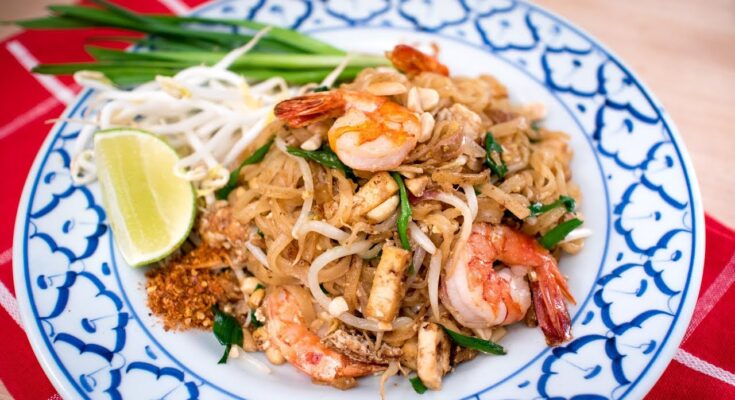Pad Thai Sauce Recipe: If you’ve ever wandered through the bustling streets of Bangkok or watched street vendors fire up their sizzling woks, you know Pad Thai isn’t just food—it’s an experience. Pad Thai represents a harmony of flavors: sweet, tangy, salty, and just a hint of spice. But what really brings that plate of noodles to life? The sauce.
Without the sauce, Pad Thai would be just stir-fried noodles. It’s the soul of the dish. A single spoonful can awaken your taste buds with its depth and complexity, combining simple ingredients into something truly unforgettable. That’s what makes Pad Thai sauce such a crucial part of the dish—it’s not just a topping; it’s the main character.
Why the Sauce Matters Most
The beauty of Pad Thai lies in its balance. The sauce has to juggle four bold elements: sweetness (usually from palm sugar), saltiness (from fish sauce), sourness (from tamarind), and heat (optional chili). Each plays its part. Too much of one and your dish could lean into being too sweet or too salty. Too little, and it might feel bland.
Creating the sauce from scratch may seem intimidating at first, but it’s actually pretty straightforward once you know the ratios. And the reward? A sauce so good, you’ll never want to use a store-bought bottle again.
Key Ingredients for Authentic Pad Thai Sauce
Essential Ingredients You Can’t Skip
If you’re aiming for that unmistakable traditional flavor, these are the non-negotiables:
- Tamarind Paste: This brings the tangy punch. Tamarind adds that mouth-puckering, slightly fruity sourness which gives Pad Thai its distinct zing. You can find this in most Asian supermarkets or online.
- Fish Sauce: This funky-smelling bottle holds an ocean of umami. Don’t let the aroma scare you—fish sauce adds that rich, salty depth that no substitute can truly mimic.
- Palm Sugar or Brown Sugar: Traditionally, palm sugar is used for its mild caramel flavor, but dark brown sugar works as a great alternative.
- Water: A little water helps dissolve the sugar and mix everything evenly.
Optional, but highly recommended:
- Chili Flakes or Chili Paste: For those who like a kick, spice it up.
- Garlic: For a touch of pungency that enhances everything.
These few ingredients come together like magic. When mixed right, they create a sauce that dances on your palate.
Finding Substitutes When Needed
Can’t find tamarind paste or fish sauce? Don’t worry, you’ve got options.
- Tamarind Substitute: Mix lime juice with a little rice vinegar for acidity, or use ketchup in a pinch for both color and tang (though this will change the flavor quite a bit).
- Fish Sauce Substitute: Soy sauce combined with a touch of Worcestershire sauce can get you closer to the umami of fish sauce. For vegan versions, look for mushroom soy sauce or vegan fish sauce alternatives.
Just remember, substitutes are great, but if you want the real deal taste—you’ll want the originals.
Step-by-Step Guide to Making Pad Thai Sauce
Step 1: Prepping the Ingredients
Preparation is key. You want to have everything measured and ready to go before turning on the heat.
Here’s what you’ll need:
- 2 tablespoons tamarind paste
- 3 tablespoons fish sauce
- 3 tablespoons palm sugar (or dark brown sugar)
- 1/4 cup water
- Optional: 1/2 teaspoon chili flakes, 1 minced garlic clove
Make sure your tamarind paste is smooth. If it’s chunky or thick, you can mix it with warm water and strain out the seeds or fibers. Crush or grate the palm sugar if it comes in blocks so it dissolves easily.
Step 2: Mixing the Sauce
Now that your ingredients are ready, it’s time to bring them together.
- Place a small saucepan over medium heat.
- Add water, sugar, and tamarind paste. Stir continuously until the sugar is fully dissolved.
- Add in fish sauce and mix well.
- Optional: Add chili flakes and garlic for an extra depth of flavor.
- Let the mixture simmer gently for 3–5 minutes, allowing the flavors to meld and the sauce to slightly thicken.
Don’t walk away from it—this step happens fast, and you don’t want the sugars to burn. Your kitchen will smell incredible as the sauce simmers.
Step 3: Cooking the Sauce
Once everything is dissolved and simmered down to a slightly sticky texture, remove it from heat. You should have about half a cup of rich, amber-brown Pad Thai sauce ready to go.
Taste it. Yes, taste it! Adjust if necessary. Too sour? Add a pinch more sugar. Too salty? A splash of water or a touch of lime juice can mellow it out.
Your sauce is now ready to use. Add it to freshly stir-fried rice noodles, toss in your protein (shrimp, tofu, chicken), bean sprouts, green onions, and top it off with crushed peanuts and a lime wedge—hello, flavor explosion.
Tips to Customize Your Pad Thai Sauce
Sweet, Sour, or Spicy – Balance It Your Way
One of the greatest things about making Pad Thai sauce at home is that you can tweak it to suit your personal preferences. Love bold flavors? Want it extra spicy or super tangy? Go for it!
Let’s break down how you can adjust the flavor profile:
- For More Sweetness: Add a bit more palm sugar or brown sugar. This works especially well if you’re adding a lot of spicy or sour components and need to mellow them out.
- For More Sourness: Add extra tamarind paste or a squeeze of lime. Tamarind gives a deep, complex tang, while lime brightens the sauce.
- For More Heat: Chili flakes, chili paste, or even a dash of Sriracha can spice things up. Start small—you can always add more!
- For More Umami: A little extra fish sauce or a splash of soy sauce (especially dark soy for richness) can give that savory depth.
Want to add a personal flair? Try mixing in a splash of rice vinegar or even a dab of peanut butter for a creamy texture—perfect if you’re adding it to tofu or chicken. Customizing the sauce means you’re no longer just following a recipe—you’re creating your own signature Pad Thai.
How to Make it Vegetarian or Vegan
Want to make your Pad Thai sauce plant-based? Totally doable—and still delicious.
Here’s how to swap things out:
- Replace Fish Sauce: Use soy sauce, tamari (for gluten-free), or vegan fish sauce made from seaweed and mushrooms.
- Watch the Sugar: Some palm sugars are processed with animal byproducts, so opt for organic or raw cane sugar if you’re strict about it.
- Boost the Umami: Add a teaspoon of mushroom powder, a splash of liquid aminos, or miso paste for extra savory goodness.
Once you’ve got these swaps in place, the rest of your dish can be totally vegan too—think tofu, rice noodles, bean sprouts, and crushed peanuts. You won’t miss the meat or seafood at all when your sauce is this flavorful.
How to Store and Use Pad Thai Sauce
Storage Tips for Freshness
Let’s say you made a big batch (which, honestly, is a smart move). Here’s how to keep your Pad Thai sauce tasting fresh for as long as possible:
- Refrigerator: Store in an airtight glass jar or bottle. It’ll last up to 2 weeks in the fridge.
- Freezer: Want to save it for even longer? Freeze it in silicone ice cube trays, then transfer the frozen cubes into a ziplock bag. They’ll stay good for up to 3 months.
- Pro Tip: Label your container with the date you made it. It’s easy to forget how long it’s been sitting there.
Always give it a quick sniff and taste before using if it’s been in storage. If it smells off or separates weirdly, it’s best to whip up a new batch. But honestly, with how tasty it is, you’ll probably go through it faster than expected.
How Long It Lasts and How to Reheat
So you’ve got leftover sauce—great! But how should you reheat it?
- Stovetop: Gently warm it over low heat in a saucepan. Stir occasionally to avoid burning.
- Microwave: Use short 15–20 second bursts, stirring in between. Don’t overdo it, or you’ll caramelize the sugars too much.
When stored properly, your Pad Thai sauce will hold up beautifully. Just give it a quick shake or stir before using again to remix all those amazing flavors.
And remember, this sauce isn’t just for noodles—you can use it as a marinade, stir-fry base, or even a dipping sauce. It’s that versatile.
Creative Ways to Use Pad Thai Sauce Beyond Noodles
Think Outside the Wok
While Pad Thai sauce was born to coat noodles, its complex flavor profile makes it incredibly versatile in the kitchen. Once you’ve got a jar of this liquid gold, the possibilities are endless.
Here are some creative ways to use it:
- Stir-Fry Anything: Whether it’s veggies, tofu, or shrimp, toss them in a spoonful or two of Pad Thai sauce during cooking for instant flavor.
- Marinate Proteins: Chicken, pork, tofu, or even mushrooms soak up the sauce beautifully. Let it sit for 30 minutes to an hour before grilling or roasting.
- Pad Thai Fried Rice: Yep, swap out the noodles for rice and give it a quick toss with eggs, scallions, and your protein of choice.
- Dipping Sauce: Add a touch more sugar and chili, then serve it with spring rolls, dumplings, or grilled skewers.
- Lettuce Wraps: Use the sauce to flavor ground meat or tempeh, then serve it in crisp lettuce cups with shredded carrots and peanuts.
When you start using Pad Thai sauce beyond its traditional role, you unlock a whole new world of Thai-inspired meals that are fast, flavorful, and just as satisfying.
Common Mistakes to Avoid When Making Pad Thai Sauce
Little Errors, Big Impact
Even with simple ingredients, there are a few easy missteps that can throw off your sauce game. Here’s what to watch out for:
- Skipping Tamarind: It’s tempting to substitute it with lime juice or vinegar, but that deep sour complexity just isn’t the same. If you’re after authenticity, tamarind is a must.
- Overpowering with Fish Sauce: A little goes a long way. Too much and you risk a salty, overpowering dish. Stick to the ratio and adjust at the end if needed.
- Using Raw Garlic Without Cooking: If you’re adding garlic to your sauce, make sure it gets cooked slightly—either in the sauce or while stir-frying. Raw garlic can taste too sharp and ruin the balance.
- Burning the Sugar: Cook on medium to low heat and stir constantly. Burnt sugar adds a bitter taste that’s hard to fix.
- Forgetting to Taste and Adjust: Always taste before serving. Sometimes your tamarind is extra sour or your sugar more intense—it’s okay to tweak until it feels right for you.
Avoid these common pitfalls, and your Pad Thai sauce will shine every single time.
Nutrition and Health Benefits of Homemade Pad Thai Sauce
Cleaner Ingredients, Better Flavor
Let’s be honest—store-bought sauces are convenient, but they often come packed with preservatives, additives, and loads of sodium. When you make Pad Thai sauce at home, you control exactly what goes in.
Here’s why homemade wins:
- Lower Sodium: You can reduce the amount of fish sauce or use low-sodium soy sauce.
- No Preservatives: Fresh ingredients mean cleaner eating.
- Customizable Sugar Levels: Cut back on sugar or use alternatives like coconut sugar, honey, or agave.
- No MSG: Unless you add it, you’re staying MSG-free, which is important for many people with sensitivities.
In moderation, ingredients like tamarind and garlic even offer some health perks—antioxidants, anti-inflammatory properties, and digestive benefits.
It’s not “health food” per se, but when made mindfully, Pad Thai sauce can absolutely fit into a balanced, flavorful diet.
Why Making Your Own Pad Thai Sauce Is Worth It
Flavor, Freshness, and Flexibility
Sure, you could grab a bottle off the shelf. But once you make Pad Thai sauce from scratch, you’ll never look back.
Here’s why it’s worth the extra 10 minutes:
- Flavor Explosion: Freshly mixed ingredients simply taste better. You’ll notice it the moment it hits your noodles.
- Zero Guesswork: You know what’s in it, how it’s balanced, and how it fits your taste.
- Less Waste: Make only what you need or store it smartly—no more half-used bottles gathering dust.
- Pride in the Process: Cooking from scratch gives a huge sense of accomplishment. When someone compliments your Pad Thai, you’ll know it’s all you.
Homemade Pad Thai sauce doesn’t just elevate your dishes—it elevates your cooking game. And once you’ve nailed the process, you’ll want to bottle it up and give it to friends. It’s that good.
FAQs about Pad Thai Sauce Recipe
What are the essential ingredients for Pad Thai sauce?
The essential ingredients for authentic Pad Thai sauce include tamarind paste, fish sauce, palm sugar, and sometimes lime juice. These ingredients combine to create a perfect balance of sweet, sour, salty, and umami flavors that define a traditional Pad Thai.
Can I make Pad Thai sauce without fish sauce?
Yes, you can make Pad Thai sauce without fish sauce by substituting it with soy sauce or tamari for a vegetarian version. Adding a little miso paste can also mimic the umami depth of fish sauce.
How long can I store homemade Pad Thai sauce?
Homemade Pad Thai sauce can be stored in an airtight container in the refrigerator for up to a week. For longer storage, you can freeze the sauce for up to three months. Always check for any signs of spoilage before use.
Is Pad Thai sauce gluten-free?
Traditional Pad Thai sauce can be gluten-free, but it’s important to check the labels of ingredients like fish sauce and tamarind paste, as some brands may contain gluten. Using tamari instead of soy sauce can ensure your sauce remains gluten-free.
How can I adjust the sweetness or tanginess of the sauce?
Adjusting the sweetness or tanginess of your Pad Thai sauce is simple. Add more palm sugar to increase sweetness, or more tamarind paste to enhance tanginess. Always taste and adjust gradually to suit your preference.
Can I use Pad Thai sauce in other dishes?
Absolutely! Pad Thai sauce is versatile and can be used in various dishes. Try it as a marinade for grilled meats, a dressing for salads, or a stir-fry sauce for vegetables and noodles.
Is there a quick alternative to homemade Pad Thai sauce?
For a quick alternative, you can buy pre-made Pad Thai sauce from most grocery stores. However, making it at home allows for adjustments in flavor to better suit your taste preferences and dietary needs.
Conclusion
Pad Thai sauce is more than just a condiment—it’s the soul of one of Thailand’s most beloved dishes. With its delicate balance of sweet, salty, sour, and spicy, this sauce transforms simple noodles into a flavorful masterpiece. Whether you’re recreating a street food classic or adding Thai flair to your favorite meals, having a homemade batch of Pad Thai sauce on hand is a total game-changer.
By following this guide, you’ve not only learned how to make it—you’ve also unlocked the secret to mastering Thai cuisine from your own kitchen. So next time you crave that irresistible Pad Thai flavor, skip the takeout and make it yourself. You’ll taste the difference in every bite.



